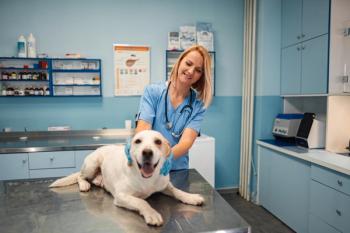
4 new ways to talk to veterinary clients
Creative, reflective client communication tactics for any exam-room interaction dotted Dr. Sarah Wootens talk at the most recent Fetch dvm360 in San Diego.
Could new ways of speaking and thinking tune up your veterinary recommendations to pet owners? (Africa Studio/stock.adobe.com)Sarah Wooten, DVM, CVJ, got “meta” at the start of her session “What The Lion King and Trojan horses can teach us about motivating clients” at
She started by using a metaphor for motivation for veterinary clients, metaphors being one of her four favorite methods for explaining things in the exam room to confused, agitated or stressed pet owners. That's right: She kicked off a session educating attendees with one of her tactics for educating your clients.
Some clients, she says, are hybrid cars, internally motivated, who just go, go, go with proverbial gas straight to your veterinary practice having researched and understood what's happening with their pet and ready to accept your recommendations.
Some clients, however, are “gas guzzlers” and you need to keep “pouring all this motivation into them” before, during and after appointments, Dr. Wooten says.
Metaphor was one of four tools Dr. Wooten shared with attendees to motivate clients. Here are the very basics (minus audience engagement and Dr. Wooten's upbeat teaching style):
Metaphors tell a story
This may be an obvious one (we started with it above), but if you stop and think about it, are you sure use it enough? Metaphors (X is X), similes (X is like X) and analogies (“See, clients are cars, and your educational work is the gas … “) are common storytelling and educational tactics that bring home complicated or difficult ideas. They cut past medical jargon and assumptions about what people are prepared to understand about medicine.
“They can help clients understand, they create familiarity with an idea,” Dr. Wooten says. “They trigger emotions, and they motivate clients.
“I love it particularly when metaphors are humorous.”
Dr. Wooten's favorite example is “dog jail,” which she uses to explain mandatory cage rest at home. (Why? When she asked how cage rest was going at home, Dr. Wooten says sometimes clients would come back with, “Oh, good, he's on cage rest, but I let him run around outside and up and down the stairs.”) “Dog jail” gets the point across the dog owners, she says, and some even appreciate the humor, taking social media pics of the dog and telling everyone in their social circle about dog jail and how it's going.
The metaphor transforms something difficult and routine-breaking into something a little funny and a little fun.
The 'mere-exposure effect' is about repetition
Sharing a common stat that an ad needs to be seen seven times before it sinks in and starts changing a consumer's behavior, Dr. Wooten encouraged the veterinarians, veterinary technicians and practice managers in the room to consider the ways they can put this to work for education.
The so-called mere-exposure effect is the fact that we “tend to develop a preference for things merely because we're familiar with them,” Dr. Wooten says. When it comes to the major client education issues that attendees says they say they struggle with-the top three were obese pets and the importance of dental prophlyaxes and rechecks-she worries they just don't get the messages often enough.
“We're only seeing some of these clients once or twice a year,” Dr. Wooten says. “We've gotta' get these concepts in front of clients more often than we do.”
More education on social media, more and better education in print and e-newsletters, or more and better signage in and around a practice's building could be ways to share and share again the messages you think are most important.
Don't think manipulation-think 'masks'
The famous Trojan horse from Greek history was Dr. Wooten's inspiration for this-minus the fact that that deception was soldiers trying to sneak into a city to sack it. This is about considering what clients value and trying to bring that closer to what you value for the health of the pet. It's putting on a mask, changing the way you're communicating and what you emphasize, all for the good of the pet and the client.
“Use your creativity to come up with new ways to link agendas with values that clients already hold,” she says. For example, in Greeley, Colorado, where Dr. Wooten has practiced, heartworm disease doesn't show up a lot, but the veterinarians feel strongly preventive is necessary. And she noticed heartworms weren't a selling point for the multiworm parasite control.
“But worms seemed to really bother them. So I say, ‘This is your internal parasite control. This is what will keep the worms out of your pet and your children,'” Dr. Wooten says. “Instead of assuming that clients share our values, or trying to convince them to change, we need to present our values as a means of pursuing theirs.”
Maybe the reason you think parasite control is important doesn't mesh with that pet owner on that day. So what “mask” can you wear to educate and motivate?
Motivational counseling is all about questions
Motivational counseling has bubbled up from psychology and especially substance abuse issues, Dr. Wooten says, and is a client-centered counseling style for eliciting behavior change by helping clients to explore and resolve ambivalence.
What does that mean? It means asking “why not?” with open-ended questions, because Dr. Wooten says “direct persuasion is not an effective method for resolving ambivalence.”
Examples could be:
> Help me understand X.
> What are the good things about X and what are the less good things about it?
> When would you be most likely to X?
> What have you tried before to make a change?
> What do you want to do next?
> How can I help you in this?
“Motivational counseling focuses on eliciting the client's thoughts,” Dr. Wooten says. “The veterinarian is directive in helping the client examine and resolve ambivalence.”
Dr. Wooten capped off the session by asking attendees to put the tactics to work in brainstorming new ways to talk about tough topics like obesity, parasiticides and rechecks. One highlight on parasite preventives? “You know how you need birth control so you don't have more babies?” said one attendee. “Well, this is like birth control for fleas.”
Nobody copyrighted it, so now “flea birth control” can be your metaphor too.
Newsletter
From exam room tips to practice management insights, get trusted veterinary news delivered straight to your inbox—subscribe to dvm360.






